Archive
CBM prg Studio v3.2.1 released

CBM prg Studio Version 3.2.1 is released. There are a lot of new features in this version. I’d really appreciate it if you report any bugs you find or have any suggestions/comments.
CBM prg Studio allows you to type a BASIC or Machine Code program in using a nice Windows environment and convert it to a ‘.prg’ file which you can run on an emulator, or even a real C64 / VIC20 or PET if you’re feeling brave and have the right kit.
CBM prg Studio is the result of merging C64PrgGen and VIC20PrgGen. Adding new features and fixing bugs in two apps which were 95% similar was a bit of a nightmare so merging them made sense.
It was also a good opportunity for a face lift and to add some new features, such as:
- Programs are project based, meaning all related source files, sprite files etc. are kept in one place and multiple source files can be linked more easily.
- Tabbed MDI.
- Syntax highlighting.
What CBM prg Studio isn’t is a front-end for tok64, cbmcnvrt, bastext or any other tokeniser / detokeniser / assembler. It’s all been written completely from scratch.
New features:
- Screen designer speed up.
- Speed up of switching/adding/opening files and projects.
Bug Fixed:
- Assembler:
- Duplicate labels not detected in projects.
- SYS call always created at start of file.
- Build order not correct.
- Assembly dump showing both parts of the code within conditional assembly statements.
- Code reformatting issues.
- Negative numbers in BYTE and WORD sequences not assembled properly.
- Numbers in strings in BYTE sequences not assembled properly.
- Numbers in TEXT sequences not assembled properly.
- Arithmetic in WORD sequences not assembled properly.
- General:
- Sprite Designer grid glitches.
- Exception thrown when generating .prg with the output window closed.
- Code indent/outdent/comment/uncomment would add extra carriage return.
- Code comment/uncomment would add extra REM statements.
- Problem adding existing files to a project.
Download: CBM prg Studio v3.2.1 (1165)
source: ajordison.co.uk
A couple of Texas Instruments TI-99/4A Home Computer repaired
 I have repaired nine motherboards of the Home Computer Texas Instruments TI-99/4A for a dear friend. Below the description of each repair.
I have repaired nine motherboards of the Home Computer Texas Instruments TI-99/4A for a dear friend. Below the description of each repair.
Texas Instruments TI-99/4A Repair (1 of 9)
Defect:
- Blue Screen with tiny Vertical lines and deafening sound … and then garbage screen.
Replaced parts:
- 1 x 1501392-27 ROM (U611)
- 2 x 4116 RAM (U102 / U105)
- 1 x 74LS245 OCTAL BUS TRANSCEIVER (U614)
- 1 x 74LS03 QUAD 2-INPUT NAND GATE (U506)
Texas Instruments TI-99/4A Repair (2 of 9)
Defect:
- Blue Screen with tiny Vertical lines and deafening sound.
Replaced parts:
- 1 x CD3227A ROM (U611)
- 1 x CD3226A ROM (U610)
Texas Instruments TI-99/4A Repair (3 of 9)
Defect:
- Garbage Screen.
Replaced parts:
- 4 x 4116 RAM (U105 / U106 / U108 / U109)
Texas Instruments TI-99/4A Repair (4 of 9)
Defect:
- Blue Screen with tiny Vertical lines and deafening sound.
Replaced parts:
- 1 x MCM 6810P RAM 128×8 (U609)
Texas Instruments TI-99/4A Repair (5 of 9)
Defect:
- Blue Screen with tiny Vertical lines and deafening sound.
Replaced parts:
- 1 x MCM 6810P RAM 128×8 (U608)
- 1 x 1501392-27 ROM (U611)
- 1 x 74LS138 1-OF-8 DECODER/DEMULTIPLEXER (U504)
Texas Instruments TI-99/4A Repair (6 of 9)
Defect:
- Blue Screen with tiny Vertical lines and deafening sound.
Replaced parts:
- 1 x CD3226A ROM (U610)
- 1 x 74LS138 1-OF-8 DECODER/DEMULTIPLEXER (U504)
Texas Instruments TI-99/4A Repair (7 of 9)
Defect:
- Blue Screen with tiny Vertical lines and deafening sound.
Replaced parts:
- 1 x TMS 9900-NL CPU (U600)
What happened to the other two motherboards ?
- The eighth motherboard was used for spare parts.
- The ninth motherboard has all components burned (Power Supply problem?)
C64 Game: Ninja Commando +44D / Quo Vadis +4DG &Editor &Map …
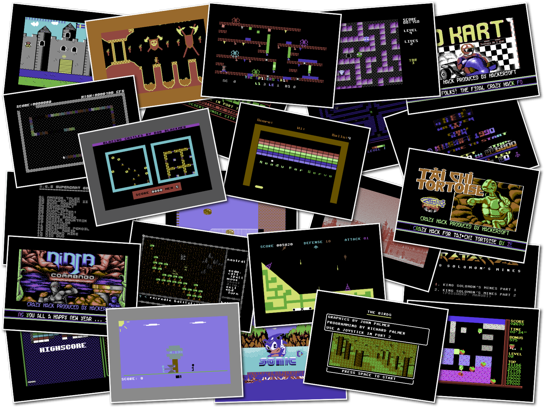
Some new games or tools (Cracked / Trained or Unrealeased) for Commodore 64 have been released from your favorites groups.
Titles:
- Linnan Valtaus +
- Old Sam +2
- Cherry Picker +
- Shootin’ Putin (lightgun & joystick)
- Shootin’ Putin (lightgun & joystick) +
- Tree Some +1D
- The Search for King Solomon’s Mines 101%
- Colorout +
- Melting Trail +H
- Sonic the Hedgehog Preview
- Brick Buster 2015 +3D
- Penultimate Fantasy V1.1
- Tai Chi Tortoise +47D [crazy hack]
- Blazing Castles +4D
- The Birds +4ED
- Brick Buster! [paddle/joystick]
- Gem Quest Preview +4
- Vee Kloros +
- Bowman +3D &Editor
- Tutti Frutti 64
- Go-Kart Simulator +37D [crazy hack]
- Tutti Frutti 64 +5
- Battle Khaos II
- Ninja Commando +44D [crazy hack]
- Bunker +5ED
- Brilliant Maze +5HD
- Quo Vadis +4DG &Editor &Map
- Supercart 60-in-1 [easyflash]
Download: All Games in One Archive (3453)
source: csdb.dk
Dick Smith Wizzard (CreatiVision) MultiRom v1.0 Test & Upgrade
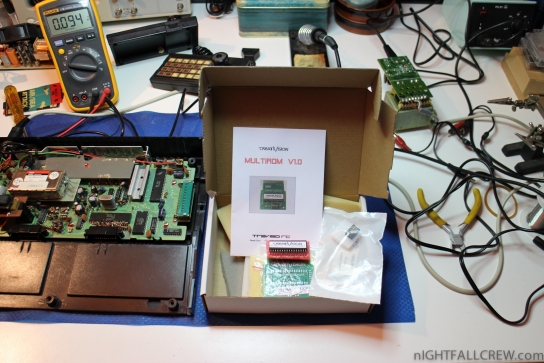
The Creativision console was given to me on loan from a friend, Andrea Pierdomenico for testing the MultiROM v1.0 cartridge made by Treviso RC (Francesco Brolli)
I and Andrea we realized that the power supply was lost (tragedy). The original power supply of the CreatiVision uses 16v in AC 350ma and 9v in AC 1amp.
Here comes Ciro (Ninetyniner Iuc) that months ago gave me a transformer extirpated from a unknown motherboard and with a bit of fortune there are all voltages.
At this point, given the poor quality of the output video via antenna that comes with the Creativision i have decided to make the easy Composite Video/Audio mod and acting on the Trimmer (color gain) native on the PCB of Creativision i have reached a good quality of the image.
I must thank Andrea Pierdomenico, Ninetyniner Iuc and Francesco Brolli (Treviso RC) for the MultiROM Cartridge v1.0.
Gallery:
Dick Smith Wizzard (Creativision)
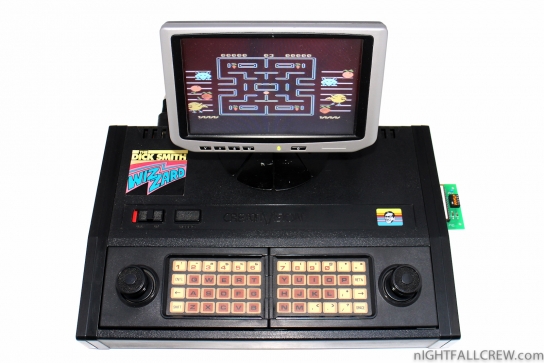
Gallery:
The Video Technology CreatiVision was a hybrid computer and home video game console introduced by VTech in 1981. The hybrid unit was similar in concept to computers such as the APF Imagination Machine, the older VideoBrain Family Computer, and to a lesser extent the Intellivision game console and Coleco Adam computer, all of which anticipated the trend of video game consoles becoming more like low-end computers.
The CreatiVision was distributed in many European countries, in South Africa, in Israel under the Educat 2002 name, as well as in Australia under the Dick Smith Wizzard name. Other names for the system (all officially produced by VTech themselves) include the FunVision Computer Video Games System, Hanimex Rameses and VZ 2000. All CreatiVision and similar clones were designed for use with PAL standard television sets, except the Japanese CreatiVision (distributed by Cheryco) which was NTSC and is nowadays much sought after by collectors.
The CreatiVision console sported an 8-bit Rockwell 6502 CPU at a speed of 2 MHz, 1KB of RAM and 16KB of Video RAM, and had a graphics resolution of 256 × 192 with 16 colors and 32 sprites. The console had 2 integrated joystick/membrane keypad controllers (much like the ColecoVision) which, when set in a special compartment on top of the console, could be used as a computer keyboard. The CreatiVision had interfaces for a cassette player, an extra rubber keyboard, floppy disk drive, parallel I/O interface, modem (likely unreleased), Centronics printer and one memory expansion module for use with the Basic language cartridge.
The CreatiVision was discontinued in late 1985/early 1986. A computer was produced by VTech in 1984-1986, based on CreatiVision hardware and compatible with most of the games: Laser 2001, which sold in Europe and Australia. It was also available in Finland through Salora, with the name of Manager. The Manager had a specific keyboard with Finnish layout and character set.
source: wikipedia
Repair Atari Falcon with a dead Keyboard
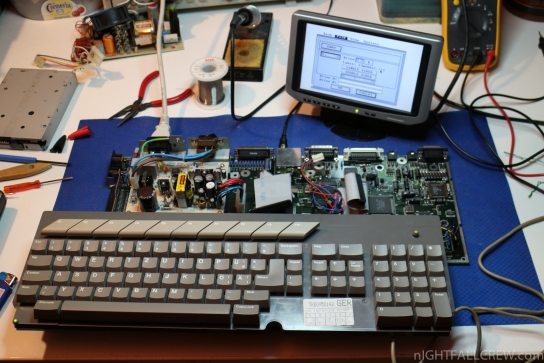
Repair Atari Falcon with a dead Keyboard.
Defect:
- Dead Keyboard.
Repairing:
The defect was caused by a broken track in the third layer of the pcb, thus not visible. Missing the voltage of +5v from the component (L83) towards the pin four of the keyboard connector (J18) (circuit diagram).
I have made a small bridge for fix the problem permanently.
Cleaning Commodore CDTV Keyboard
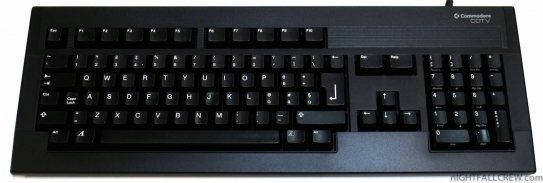
Cleaning Commodore CDTV Keyboard:
The Commodore CDTV Keyboard it’s nothing more than a Amiga 3000 keyboard, black with a different connector.
Recovery electronic components from a motherboard
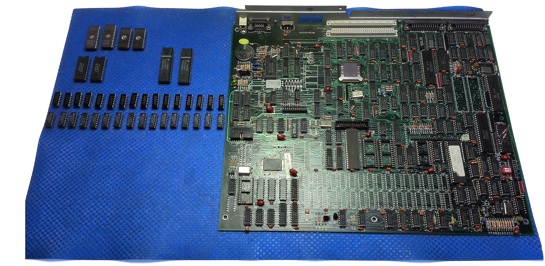
Recovery electronic components from a motherboard that was given to me.
Components recovered:
- 2 x INS 8250N (UART)
- 2 x 2764 (EPROM)
- 2 x 2732 (EPROM)
- 2 x HM 6264P-15 (STATIC RAM)
- 16 x TMS 4256-15 (RAM)
- 16 x MB 8264A-15 (RAM)
High Voltage SID Collection Update #62

The High Voltage SID Collection (HVSC) is a freeware hobby project which organises Commodore 64 music (also known as SID music) into an archive for both musicians and fans alike.
The work on the collection is done completely in the Team and contributors’ spare time and is proudly one of the largest and most accurate computer music collections known.
This update features (all approximates):
- 639 new SIDs
- 168 fixed/better rips
- 1 repeats/bad rips eliminated
- 181 SID credit fixes
- 7 SID model/clock infos
- 7 tunes from /DEMOS/UNKNOWN/ identified
- 5 tunes from /GAMES/ identified
- 20 tunes moved out of /DEMOS/ to their composers’ directories
- 6 tunes moved out of /GAMES/ to their composers’ directories
Download:
source: www.hvsc.c64.org
YMT-Player by Peter Jørgensen (aka: Fedepede)
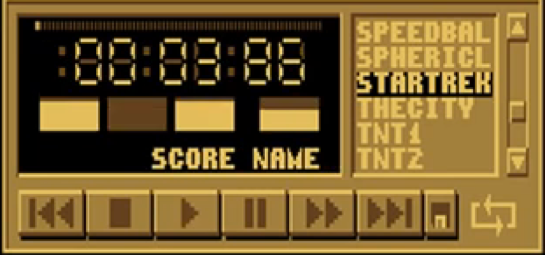
YMT-Player is a player that allow you to play Project-Ymer YMT files (Windows) on the Atari ST. The program is made by Peter Jørgensen aka. fedepede.
What is Project-Ymer YMT files ?
YMT files are like the YM/AY files. Music files where you sampled data from the sound chip register (YM2149/AY8910) in a certain interval, instead of having a dedicate player. Up to now (to my knowledge), there have only been YM/AY player that could play tune/score files, that was sampled at 50HZ, but the YMT player can play files up to 300hz (there are some 50hz+ tunes/scores include in the examples)
The advantaged of AY/YM/YMT format, is that to replay these tunes/scores cost very little CPU power, so if you need a lot power for a eg. a 3D demo, when it could be a wise choice to use it, because it leaves most of the CPU power for 3D calculations and the graphic etc, and the disadvantaged is that it use a lot of memory, and also that it is nearly impossible to make a routine that can capture and use the SID sound and Samples etc. It is also why those files need to be hand made, that is the reason why YMT-Player only support pure YM2149 sound.
The rar archive both contain a Floppy and a HD version.
Download: YMT-Player (1422)
The Program in action on Youtube.
source: fedepede04.dk
(Italian) Jurassic News numero #51
Sorry, this entry is only available in Italian.
C64 Game: Revelation +5DGH 101% / Honey Bee +29D …
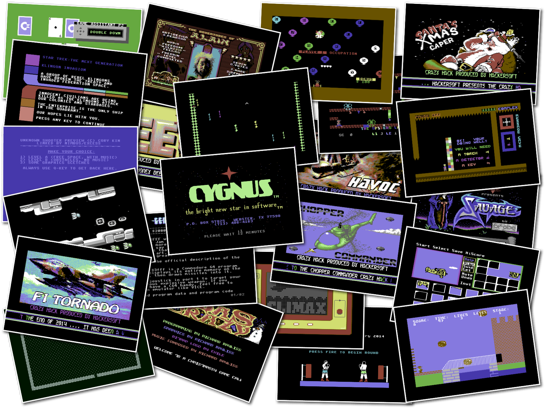
Some new games or tools (Cracked / Trained or Unrealeased) for Commodore 64 have been released from your favorites groups.
Titles:
- Savage [jewel]
- Blackjack aka Twenty-One +2 DE
- Star Trek: The Next Generation
- Honey Bee +29D [crazy hack]
- Mini Arcade: Climax +3FD [pal/ntsc]
- Havoc +18D [crazy hack]
- $2000-$3fff &D
- Boxing Manager 2 +2D
- Chopper Commander +29D [crazy hack]
- Vertical Shooter Preview
- Ah-Type Preview
- Unknown Shooter Preview
- Stinger! +3D [onefiled]
- Target Renegade +7DG +Pic 101%
- Revelation +5DGH 101%
- Xmas Crazy +5
- Confused? +D
- Santa’s Christmas Caper +25D [crazy hack]
- Complex +2D
- The Adventures of Alain [seuck]
- Boom and Bust +2
- Melting Trail
- Props +
- Cherry Picker +
- Old Sam +2
- F1 Tornado +27D [crazy hack]
Download: All Games in One Archive (3152)
source: csdb.dk
Dick Smith System 80 MK I (aka Video Genie and PMC-80/81)
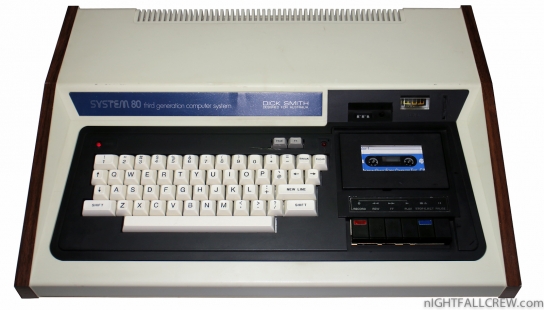
Video Genie (or simply Genie) was a series of computers produced by Hong Kong-based manufacturer EACA during the early 1980s. They were compatible with the Tandy TRS-80 Model I computers and could be considered a clone, although there were hardware and software differences.
The computers making up the series were:
- Video Genie System (EG3003 – first version, early/mid 1980)
- Video Genie System (EG3003 – second version, late 1980)
- Genie I (EG3003 – third version, late 1981)
- Dick Smith System 80 MK I (EG3003)
- Genie II (EG3008 – late 1981)
- Disk Smith System 80 MK II (EG3008)
- Genie III (EG3200 – mid 1982) – a more business-oriented machine with CP/M-compatibility.
Although Video Genie was the name used in Western Europe, the machines were sold under different names in other countries.
In Australia and New Zealand they were known as the Dick Smith System 80 MK I (EG3003) and System 80 MK II (EG3008), and in North America they were sold as the PMC-80 and PMC-81. In South Africa the Video Genie was sold as the TRZ-80, a name similar to its rival.
In early 1983, the related Colour Genie machine was released by EACA.
Features:
- CPU: Zilog Z80, at 1.76 MHz
- Video: Monochrome
- 64×16 / 32×16 uppercase text
- 128×48 block graphics
- Composite video output, cable included
- RF TV signal output, cable included
- 16 KB RAM, expandable to 48 KB
- 12 KB ROM containing Microsoft LEVEL II BASIC
- Storage: Built in 500 baud cassette deck
- Cable for using an external cassette deck included
- Built in powersupply
Autopsy:
source: wikipedia
Atari 800 Boxed (UK-PAL) – Atari 810 Boxed – Atari 410 Boxed
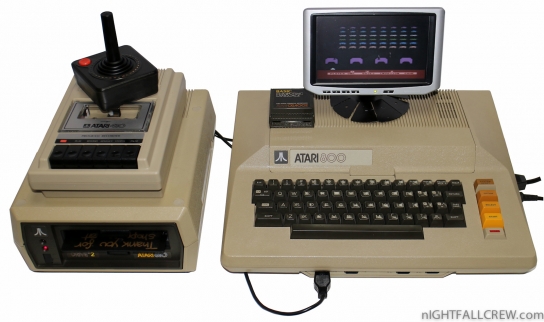
The Atari 8-bit family is a series of 8-bit home computers introduced by Atari, Inc. in 1979 and manufactured until 1992. All are based on the MOS Technology 6502 CPU running at 1.79 MHz, roughly twice that of similar designs, and were the first home computers designed with custom co-processor chips. This architecture allowed the Atari designs to offer graphics and sound capabilities that were more advanced than contemporary machines like the Apple II or Commodore PET, and gaming on the platform was a major draw – Star Raiders is widely considered the platform’s killer app. Machines with similar performance would not appear until the BBC Micro in late 1981 and the Commodore 64 in 1982.
The original Atari 400 and 800 models were released with a series of plug-n-play peripherals that used Atari’s unique “SIO” serial bus system. Over the following decade several versions of the same basic design were released, including the XL and XE series of computers and matching peripherals. All of these used the same basic logical design, with various changes to the physical layout to lower production costs as chipmaking and manufacturing processes improved over time. The early machines were expensive to build, but dependable. Later models like the XEs were greatly cost-reduced and generally not as robust. Sub-models of these later designs were sold into the eastern European market after sales of the main lineup had ended.
Overall, the Atari 8-bit computer line was a commercial success, selling two million units during its major production run between late 1979 and mid-1985, putting its sales on par with machines like the Sinclair ZX Spectrum and TI-99/4A. Its primary competition in the worldwide market was the Commodore 64, by far the best selling computer of the 8-bit era. Atari also found a strong market in Eastern Europe and had something of a renaissance in the early 1990s as these countries joined a uniting Europe. Some estimates place sales during this period at another two million units.
The early machines: 400 and 800

Management identified two sweet spots for the new computers: a low-end version known as Candy, and a higher-end machine known as Colleen (named after two attractive Atari secretaries). The primary difference between the two models was marketing;
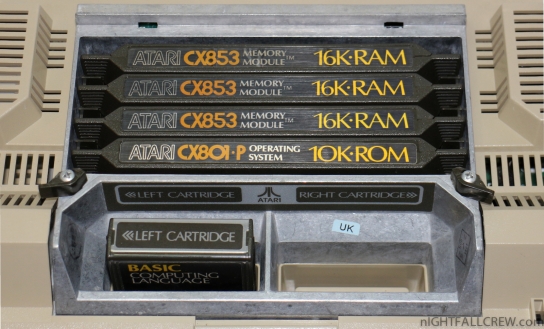
Atari marketed Colleen as a computer, and Candy as a game machine or hybrid game console. Colleen would include user-accessible expansion slots for RAM and ROM, two 8 KB cartridge slots, RF and monitor output (including two pins for separate luma and chroma) and a full keyboard, while Candy used a plastic “membrane keyboard”, non-accessible internal slots for memory, and only RF output for video.
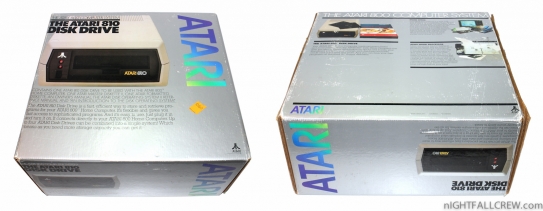
The Atari 810 Disk Drive was Atari’s first disk drive for its line of Atari 400/800 computers. Providing 88K of storage per disk side, the 810 gave Atari computer users the ability to quickly store and retrieve documents and program files to and from the storage device. Up to 4 Atari 810′s could be daisy chained together via the Atari SIO bus for a total of almost 360K of on-line random access file storage and retrieval.
The Atari 810 came in two different versions; the Tandon mech version and the MPI mech version. The Atari 810 is rather large compared to other companies disk drives and has an external 9Vac power supply. The reason why the drive is so large is that there is no disk drive controller in any of the Atari 400/800 computers, instead each device that connects to an Atari computer through its SIO bus is actually an intelligent device with its own intelligent communications controller and floppy disk controller.
The case design was conceived by Kevin McKinsey of Atari’s Home Computer Industrial Design group. The case is interesting in that the top and bottom covers are actually the same part made to assemble the top and bottom sides. Adhesive labels on the back of the 810 would block unused ports on the topside of the cover.
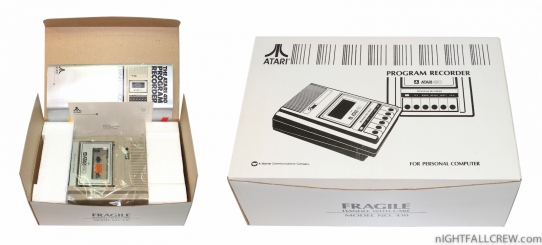
The Atari 410 came in 2 different versions, the above shown is the Atari 410a Tawain version. The Program Recorder was well built and strudy with built in power supply and SIO cable, the 410 didn’t need a bukly external power pak like most other Atari 400/800 components, how the SIO cable being built in and the Program Recorder having no daisy chain port on the unit meant that it had to be placed at the end of the SIO chain.
The original idea of the SIO (Serial I/O) port on the Atari computers was that it was to be used only for the Data cassette drive, however its functionality was extended so that it could use all Atari peripherals including disk drives, printers and modem. The Atari 410/410a had a unique feature exclusively used by Atari. They could play two seperate tracks on a tape, this proved very useful for interactive programs where a user would run a program and would hear audio music/speech while the other track would load the next part of the program.
Below a collection of a high-quality photos
source: wikipedia atarimuseum.com

















































Recent Comments